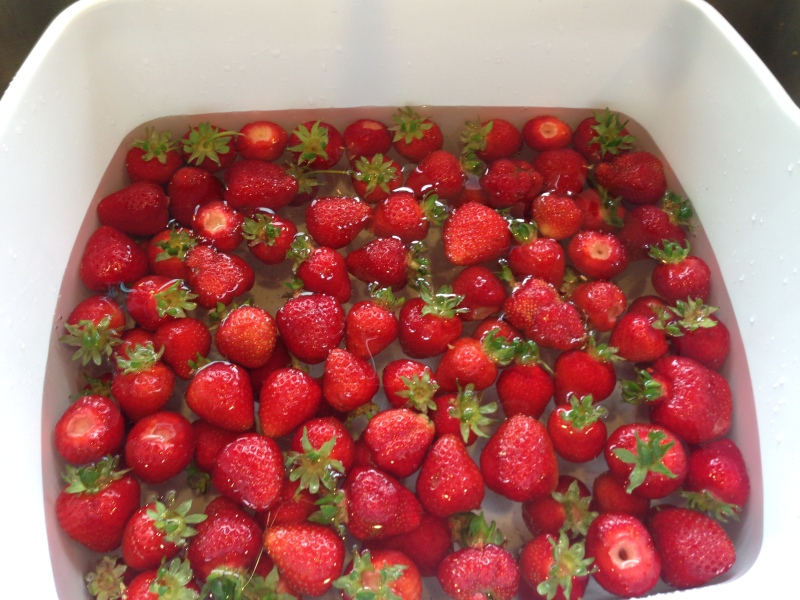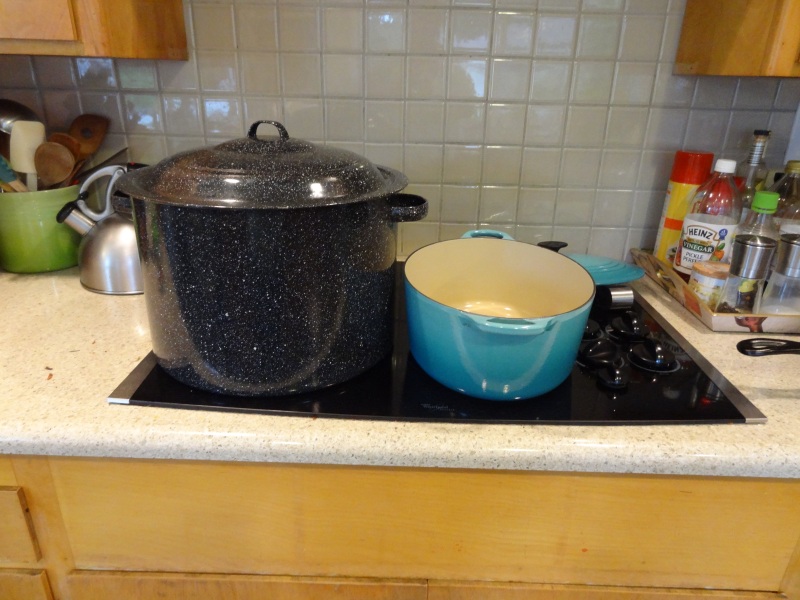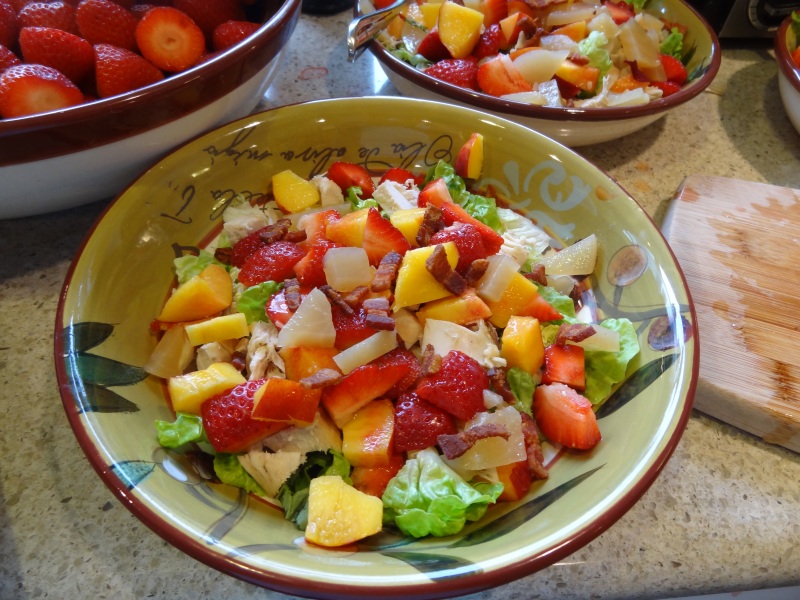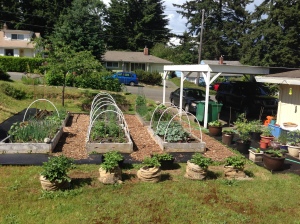Well, it’s been almost 2 years since my last blog post. I’ve intermittently felt guilt for not keeping it up, wondered if maybe I should delete the whole thing because my life was NEVER going to be normal again. But, ultimately, what it comes down to is I can’t keep myself away from gardening and I love having the chance to talk about my gardening. It really does feed my soul. I haven’t gardened since the summer of 2014, and we sold our house with all the beds we built with our own hands. I’m now living in an enormous, ugly, featureless, brown house in the suburbs. Gone are my urban dreams and now suburban ones are starting to take root.
If you’re wondering about the hiatus, there’s a long version and a short version. Most of you who read this already know my story–you lived it with me and my family–but for those of you who don’t, here is the abbreviated version.
I realized I was pregnant on the 4th of July 2014. I woke up nauseous and miserable. In August I dropped a whole lot of f-bombs when I learned that not only was I pregnant, I was pregnant with triplets! Needless to say, our world changed dramatically. Not even high-risk OBs can tell you the incidence of spontaneous, identical, triplets.
So we sold the house, we sold the car, we leased a minivan (shudder), and bought an enormous house in the ‘burbs. Then disaster hit: we developed twin-to-twin transfusion syndrome, and one of our sweet babies passed away. The docs took us into surgery to fix the problem, told us they thought they saved one of our girls, but the other remaining baby might not make it. A month later my water broke, and 4 days after that I was in an OR giving birth to 2 adorable, teeny, tiny babies who were only 26 weeks and 3 days along.
Collectively we spent 199 days in the NICU, and roughly a year ago, we all managed to live under the same roof together. Life with preemie newborns and a 3-year -old is completely insane. I have vague memories of barf, diapers, breast pumps, nursing bras and sleep deprivation. Even a year out, the hubs and I are still wondering what it must feel like to be rested….
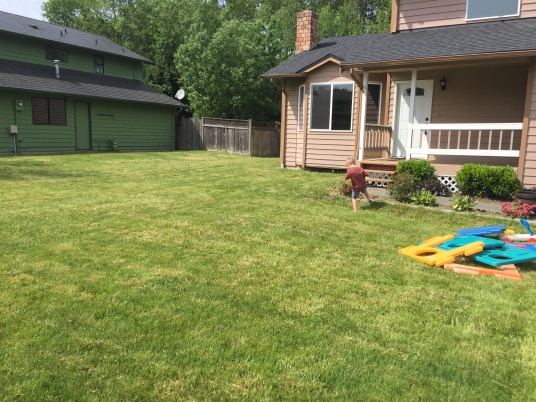
Our new house in the suburbs. Note the boring paint job and boring landscaping.
This year, the sun came out, and the grass is so green, and I needed to start gardening again. I needed to put my hands in dirt, watch things grow (plant things, not human things), and harvest my bounty. So, I put G in the minivan and drove off to Fred Meyer for some potting soil and plants. I let him pick out a lot of the plants. I honestly didn’t even care what they were as long as they weren’t flowers. We got some tomatoes, pumpkin, cucumber, basil, rosemary and lavender. A decent variety for a handful of pots and one sad, pitiful, little bed.

My helper decided to beautify the sidewalk with a rainbow, which “is made when the rain mixes with the sunshine, and that’s me playing in the grass”
I’m OK with it because I know it’s temporary. The hubs and I have BIG BIG dreams of turning our entire front and side yards into raised garden beds:I want a large keyhole bed, with a patio for chairs and literally not one blade of grass.
I want to be able to hide between my beds, sitting in an Adirondack chair with a gin and tonic in my hand.
I want my kids to roam the garden eating cherry tomatoes, raspberries, blueberries, carrots, and snap peas.
I miss eating produce that was just picked. I miss knowing exactly what I’m eating.
I miss feeling connected with Mother Earth.

Hello old friends, I’ve missed you.
So I grabbed a few pots and started planting. What I didn’t expect was that 2 years of being pretty sedentary takes a long time to overcome. I struggled picking up the bags of soil. I got tired easily, but I didn’t care. It was a happy tired, and I think I learned how to take my time and enjoy the process. I mean really, what’s the rush? I’m sure I entertained the neighbors by puttering around my tiny garden like a senior citizen.
I’m learning how to enjoy the present, be thankful for what it is, and not rush myself into the next task. What I also didn’t anticipate what the hot mess my gardening tools were in. I found myself standing in my garage repeatedly asking myself “now if I were my husband where would I put my gardening gloves/seed packets/fertilizer”. I eventually found everything, but not before ripping the garage apart. Oh well, I guess I get to start over with my organization too. There are worse things.

Finally found a use for all those empty formula cans
My son will turn 5 this summer. We spent a LONG TIME talking about how to water plants. He insisted that directly onto the leaves was best. It took some convincing that watering the base is best for the plants. He made me explain how some plants (tomatoes) could get burned if you water the leaves, or how others (zucchini) could get moldy if you water everywhere. He’s a good helper and enjoys being in the dirt with me; I just have to give him tasks to do. G enjoys anything related to digging or transporting water. He tried to dig out an ugly little bush thing but got distracted by a little snake who slithered by. We don’t always get to spend enough time just the 2 of us, I’m happy that we have gardening together back in our lives.
Life is good. Sunshine is good. Rain is good. Gardening is great.

My little slice of heaven…for now












